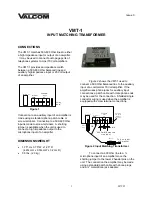
4.11
PPT ADDRESSING
The PPT provides three levels of addressing. The lowest level of address is the individual unit
address, or
device ID
. This address level is used to address any single PPT. The next level is
group
address
, which is separate from the device ID. All PPT units with the same group address will
respond to a command sent to this level address. The last is a
global address,
which is read by all
PPTs on the network. The device ID can be assigned by direct command or assigned automatically
based on its position from the host processor in PPT network. The
null address
(00) is simply a
default device ID that the PPT automatically assumes until one is assigned. That is, upon power-up,
if there is no ID assigned, and an ID has not been stored in the EEPROM, then the PPT will assign
itself the “00” null address.
The individual unit address, or
device ID
, has an assigned range from 01-89. The null address 00 is
the factory default address for unassigned PPTs. A unit with the null address, replies with a ‘null address’
header. The null address header characters are ‘?’ for ASCII format or ‘^, &, |, or %’ for binary format (see
Section 5.4 for these format types). A unique device ID allows the host processor to send commands to
specific units on a bus.
The second level of addressing is a multicast, or
group
, address in the range of 90-98. Each unit can
be assigned a group address by the ID command. A unit responds to its group address in the same
manner as it does to its global address described below. The group addressing allows the host proces-
sor to send commands to several units having the same group address. The factory default group
address is 90.
The highest level of addressing is the broadcast, or
global
, address 99. All units receive global
addressed commands. All RS-232 units respond to global commands. Only RS-485 units with as-
signed addresses will respond to global commands. An RS-485 unit with a null address will not reply
to any global command. Global addresses are not assigned but are built into the PPT.
RS-232 Ring Network
The RS-232 network consists of a three-wire bus (TD, RD, and GD) that begins and ends at the host
processor. The RS-232 electrical standard requires that the distance
between
units not exceed 60 feet
(18 meters). An advantage of the RS-232 network is that it interfaces directly to the serial COM port
of most personal computers. The maximum number of PPTs with assigned device IDs on a network is
89.
A PPT ring network connection of six units is shown in Figure 4.20. In this example, the Device IDs
are sequential, starting from 01, from the transmit port of the host processor around the loop. There
are two address groups, 91 and 93; each have 3 PPT units assigned.
Signal Ground
Host Processor
GD
TD
RD
RD TD
ID=01
Group=91
RD TD
ID=02
Group=91
Signal Ground
RD TD
ID=03
Group=93
GD - Signal Ground
TD - RS-232 Transmit
RD - RS-232 Receive
TD RD
ID=06
Group=93
TD RD
ID=05
Group=91
TD RD
ID=04
Group=93
Figure 4.20—RS-232 PPT Ring Network
2 5
















































